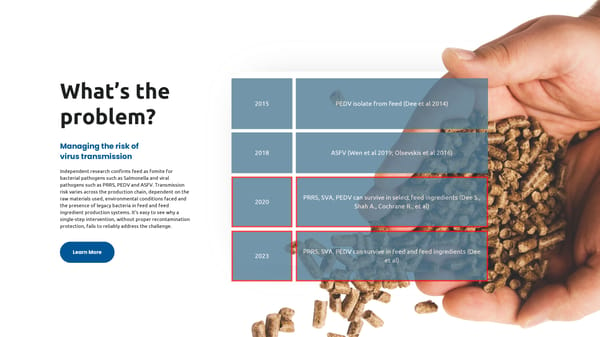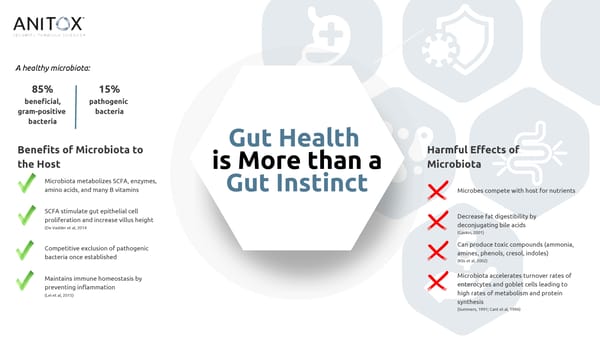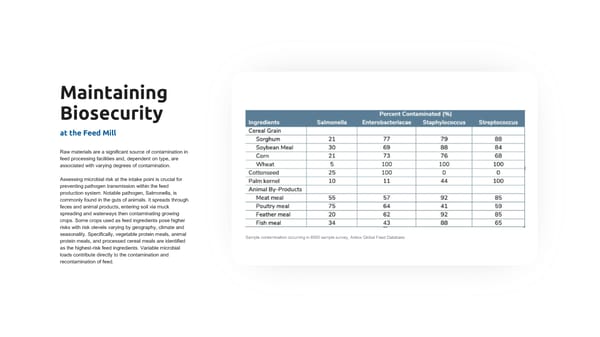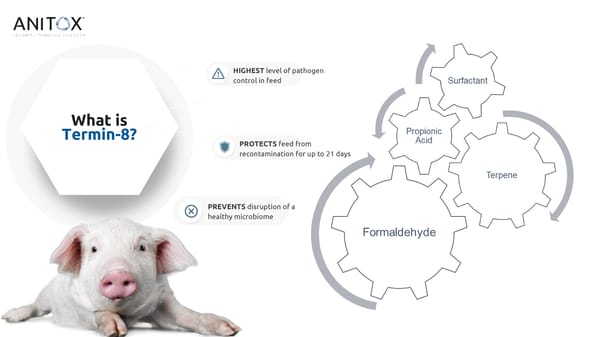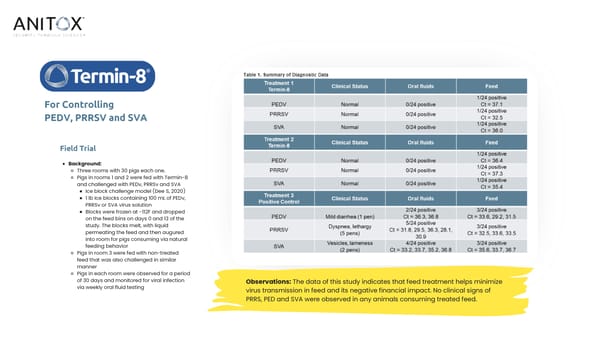Termin-8 Presentation (Swine)
FEED IS YOUR LARGEST INVESTMENT... Safeguard it with Protecting feed ingredients and finished feed against bacterial and viral contamination Explore Now
What’s the 2015 PEDV isolate from feed (Dee et al 2014) problem? Managing the risk of 2018 ASFV (Wen et al 2019; Olsevskis et al 2016) virus transmission Independent research confirms feed as fomite for bacterial pathogens such as Salmonella and viral pathogens such as PRRS, PEDV and ASFV. Transmission risk varies across the production chain, dependent on the PRRS, SVA, PEDV can survive in select feed ingredients (Dee S., raw materials used, environmental conditions faced and 2020 the presence of legacy bacteria in feed and feed Shah A., Cochrane R., et al) ingredient production systems. It's easy to see why a single-step intervention, without proper recontamination protection, fails to reliably address the challenge. PRRS, SVA, PEDV can survive in feed and feed ingredients (Dee Learn More 2023 et al)
A healthy microbiota: 85% 15% beneficial, pathogenic gram-positive bacteria bacteria Gut Health Benefits of Microbiota to Harmful Effects of the Host Microbiota is More than a Microbiota metabolizes SCFA, enzymes, Gut Instinct amino acids, and many B vitamins Microbes compete with host for nutrients SCFA stimulate gut epithelial cell Decrease fat digestibility by proliferation and increase villus height deconjugating bile acids (De Vadder et al, 2014 (Gaskin, 2001) Can produce toxic compounds (ammonia, Competitive exclusion of pathogenic amines, phenols, cresol, indoles) bacteria once established (Klis et al, 2002) Microbiota accelerates turnover rates of Maintains immune homeostasis by enterocytes and goblet cells leading to preventing inflammation high rates of metabolism and protein (Lei et al, 2015) synthesis (Summers, 1991; Cant et al, 1996)
Maintaining Biosecurity at the Feed Mill Raw materials are a significant source of contamination in feed processing facilities and, dependent on type, are associated with varying degrees of contamination. Assessing microbial risk at the intake point is crucial for preventing pathogen transmission within the feed production system. Notable pathogen, Salmonella, is commonly found in the guts of animals. It spreads through feces and animal products, entering soil via muck spreading and waterways then contaminating growing crops. Some crops used as feed ingredients pose higher risks with risk olevels varying by geography, climate and seasonality. Specifically, vegetable protein meals, animal Sample contamination occurring in 8000 sample survey, Anitox Global Feed Database protein meals, and processed cereal meals are identified as the highest-risk feed ingredients. Variable microbial loads contribute directly to the contamination and recontamination of feed.
HIGHEST level of pathogen control in feed What is Termin-8? PROTECTS feed from recontamination for up to 21 days PREVENTS disruption of a healthy microbiome
Uniform Termin-8 is a application synergistic blend Surfactant and terpene within the Broad spectrum Each ingredient enhances the formulation aid in the uniform control efficacy of its counterparts. application and disruption of cellular walls. Formaldehyde and Synergism within the formulations propionic acid interrupt critical gives Termin-8 broad spectrum cellular function leading to cell control against molds, yeast and death. bacteria.
For Controlling PEDV, PRRSV and SVA Field Trial Background: Three rooms with 30 pigs each one. Pigs in rooms 1 and 2 were fed with Termin-8 and challenged with PEDv, PRRSv and SVA Ice block challenge model (Dee S, 2020) 1 lb Ice blocks containing 100 mL of PEDv, PRRSv or SVA virus solution Blocks were frozen at -112F and dropped on the feed bins on days 0 and 13 of the study. The blocks melt, with liquid permeating the feed and then augured into room for pigs consuming via natural feeding behavior Pigs in room 3 were fed with non-treated feed that was also challenged in similar manner Pigs in each room were observed for a period of 30 days and monitored for viral infection Observations: The data of this study indicates that feed treatment helps minimize via weekly oral fluid testing virus transmission in feed and its negative financial impact. No clinical signs of PRRS, PED and SVA were observed in any animals consuming treated feed.
For Controlling Salmonella, E. Coli, Clostridium, and fungi Field Trial Background: As part of their effort to demonstrate their dedication to providing a healthier and safer environment for their livestock, an integrated pork producer in LATAM began treating all rations with 1 kg/MT of Termin-8. The organization’s primary goal was to protect its feed from harmful bacteria, including Salmonella, E. Coli, Clostridium, fungi, and certain viruses while supporting new heightened biosecurity and reduced antibiotic usage initiatives. Treatment window: 30 day trial; 3 years of continued use Application: 2.2 lb/ton Observations: After only 30 days of treatment, Termin-8 has been shown to be effective in efficiently controlling fungi and bacteria and the use of growth- promoting antibiotics in was reduced. In addition, no PEDv or ASF has been detected in feeds after nearly 3 years of routine commercial use. Mold, Aerobic Bacteria, Enterobacteriaceae and Clostridia counts in feeds were reduced by 72%, 97%, 48% and 55% respectively.

